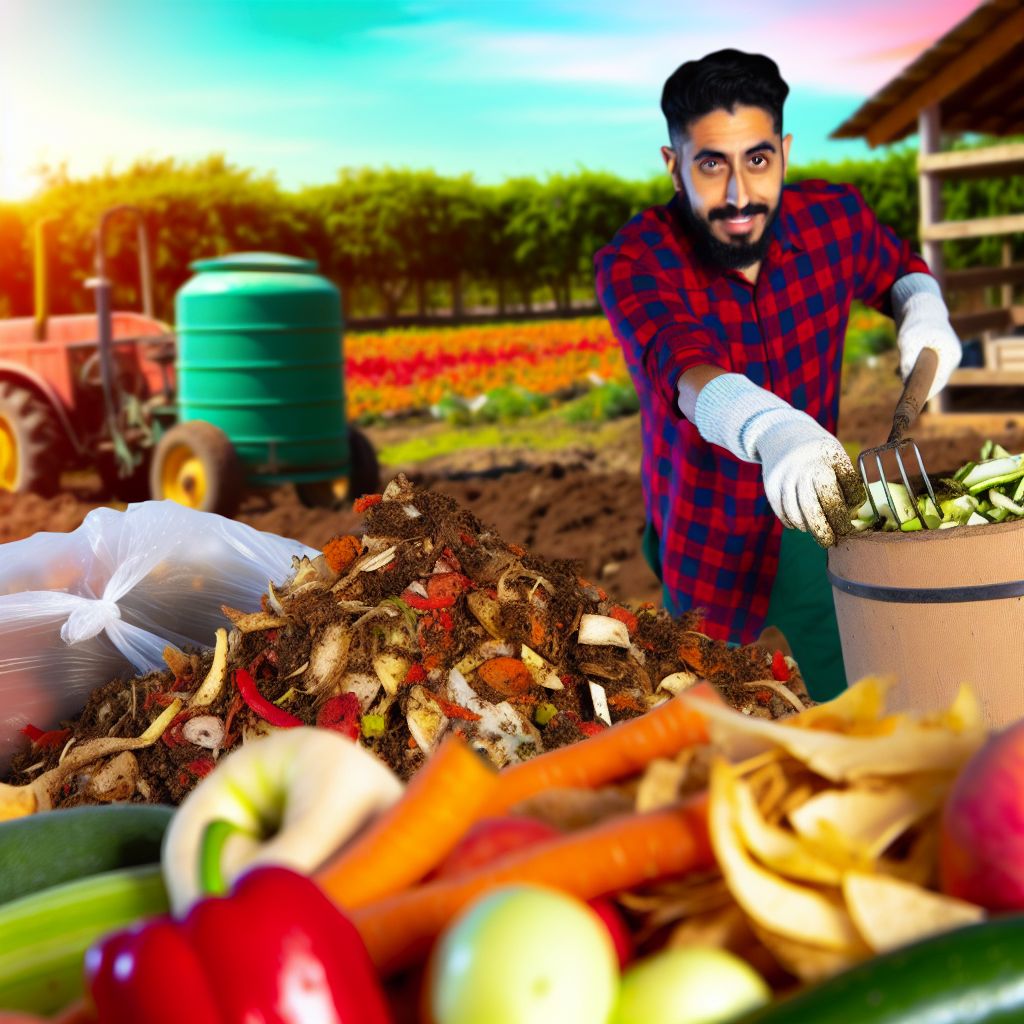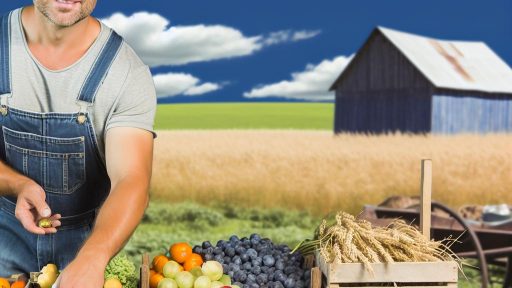Introduction to Food Waste in Agriculture
Food waste represents a significant challenge in modern agriculture.
Globally, approximately one-third of all food produced is wasted.
This waste occurs at various stages, from farm to consumer.
Agricultural activities contribute substantially to this issue.
Farmers often discard crops due to aesthetic standards.
Unharvested crops also contribute to food loss on a large scale.
Moreover, food waste generates considerable environmental repercussions.
Impact on the Environment
Food waste exacerbates climate change and resource depletion.
Decomposing food in landfills emits methane, a potent greenhouse gas.
This contributes to rising global temperatures and climate instability.
Additionally, wasted food represents a loss of valuable resources.
Considerable water, land, and energy go into food production.
When food is wasted, these resources are rendered useless.
Encouraging Regenerative Practices
Reducing food waste can enhance regenerative farming systems.
These practices focus on building and maintaining healthy ecosystems.
Transform Your Agribusiness
Unlock your farm's potential with expert advice tailored to your needs. Get actionable steps that drive real results.
Get StartedBy minimizing waste, farmers can promote sustainability.
Regenerative strategies incorporate composting and recycling methods.
This approach enriches soil health and increases biodiversity.
Consequently, healthier farms contribute to reduced waste levels.
Overview of Regenerative Farming Systems
Defining Regenerative Agriculture
Regenerative agriculture focuses on revitalizing soil health.
This farming method enhances biodiversity and ecosystem function.
Farmers implement practices that restore and maintain healthy landscapes.
Overall, regenerative agriculture aims to improve both yield and sustainability.
Core Principles of Regenerative Farming
One principle emphasizes soil health through organic matter enrichment.
This improves soil structure and moisture retention.
Another principle promotes biodiversity in crops and livestock.
It fosters ecological relationships and resilience against pests.
Additionally, regenerative farming encourages minimal tillage practices.
This reduces soil disturbance and preserves microbial life.
Crop rotation and diversity are also key components.
They disrupt pest cycles and enhance nutrient cycling.
Benefits of Regenerative Systems
Regenerative farming improves soil carbon sequestration.
By capturing carbon, it mitigates climate change effects.
This approach also increases water retention in soils.
As a result, farmers face fewer drought challenges.
Moreover, it can enhance farm profitability over time.
Healthy ecosystems support productive agriculture and communities.
Ultimately, regenerative practices lead to a more sustainable food system.
The Relationship Between Food Waste Reduction and Soil Health
Impact on Soil Nutrients
Reducing food waste directly contributes to soil health.
Showcase Your Farming Business
Publish your professional farming services profile on our blog for a one-time fee of $200 and reach a dedicated audience of farmers and agribusiness owners.
Publish Your ProfileWhen organic waste is recycled back into the soil, it replenishes nutrients.
This process enriches the soil, promoting robust plant growth.
Healthy soils retain moisture better, reducing the need for irrigation.
In turn, this leads to less water usage in farming.
Enhancing Soil Microbiome
Food waste reduction supports diverse microbial communities in the soil.
Microorganisms thrive on organic matter, improving soil structure.
This enhances aeration and drainage, benefiting root development.
A vibrant microbiome reduces disease susceptibility in plants.
As a result, farmers experience higher yields from healthier crops.
Carbon Sequestration Benefits
Reducing food waste contributes to carbon sequestration in agricultural soils.
Organic materials stored in the soil capture carbon dioxide from the atmosphere.
This process mitigates climate change effects by lowering greenhouse gas levels.
Farmers committed to food waste reduction support sustainable practices.
Consequently, they can create a more resilient agricultural system.
Linking Waste Reduction and Regenerative Practices
Food waste reduction aligns with regenerative agricultural practices.
Regenerative farming focuses on enhancing biodiversity and soil health.
Implementing waste reduction techniques fosters a closed-loop system.
Farmers can use composted waste to enrich their fields.
This approach lowers dependency on synthetic fertilizers.
Community and Economic Benefits
Communities that reduce food waste experience economic advantages.
Farmers save money by utilizing organic waste instead of buying inputs.
Additionally, less waste contributes to lower disposal costs.
This encourages local economies to thrive sustainably.
Furthermore, consumers become more aware of their food choices.
Delve into the Subject: Farm-to-Restaurant Programs for Local Farmers
Economic Benefits of Reducing Food Waste for Farmers in Regenerative Systems
Enhancing Revenue Streams
Reducing food waste significantly increases revenue for farmers.
By optimizing harvests, farmers can sell more produce.
This leads to improved financial stability and growth.
Furthermore, less waste means reduced disposal costs.
Ultimately, this allows for greater investment in sustainable practices.
Increasing Resource Efficiency
Effective waste management enhances resource efficiency.
Farmers utilize every part of their crops, minimizing losses.
This shift reduces the need for additional inputs.
As a result, costs for water, fertilizers, and labor decrease.
Sustainability improves, promoting long-term viability.
Enhancing Market Access
Lower waste levels open new market opportunities.
Consumers increasingly prefer sustainably sourced products.
This trend encourages farmers to reduce waste proactively.
Consequently, farmers can differentiate their products.
Many consumers are willing to pay higher prices for quality.
Showcase Your Farming Business
Publish your professional farming services profile on our blog for a one-time fee of $200 and reach a dedicated audience of farmers and agribusiness owners.
Publish Your ProfileStrengthening Community Relationships
Reducing food waste fosters stronger community ties.
Farmers can collaborate with local organizations to redistribute surplus food.
This enhances their reputation and builds brand loyalty.
Active involvement in the community promotes positive relationships.
Partnerships with local businesses lead to cooperative growth.
Improved Soil Health and Sustainability
Waste reduction contributes to improved soil health.
Organic waste can be composted to enrich soil quality.
Healthy soil supports increased crop yields.
Sustainable practices attract like-minded customers.
Farmers benefit economically from these ecological advantages.
Explore Further: Integrating Permaculture Guilds To Boost More Resilient Farm-To-Table Crops
Case Studies Showcasing Successful Food Waste Reduction Strategies in Regenerative Farming
Overview of Successful Strategies
Food waste reduction significantly benefits regenerative farming systems.
For instance, companies have adopted unique local sourcing methods.
These methods minimize transportation waste and enhance freshness.
Example of Local Sourcing: Green Valley Farms
Green Valley Farms illustrates effective local sourcing strategies.
They collaborate directly with local producers.
This practice reduces excess food production while supporting community farming.
As a result, the farm decreased waste by 30% in just one year.
Implementation of Technology
Advanced technology plays a crucial role in food waste reduction.
Green Valley Farms utilizes smart inventory systems.
These systems track food usage and minimize surplus inventory.
Consequently, they can predict demand more accurately.
Composting Initiatives: EcoHarvest Solutions
EcoHarvest Solutions exemplifies the benefits of composting.
They convert food scraps into nutrient-rich compost.
This compost enriches their soil, enhancing crop yields.
Moreover, it diverts food waste from landfills, significantly reducing emissions.
Composting Process at EcoHarvest Solutions
The team collects food waste from local restaurants.
Next, they sort and process this waste on-site.
After a few weeks, they produce high-quality compost.
This process not only reduces waste but also improves soil health.
Collaboration with Local Eateries: Farm-to-Table Partnerships
Partnerships with local eateries show remarkable results.
The Farm Fund Initiative connects farmers with restaurants.
These restaurants order only what they need, minimizing surplus.
Additionally, they promote seasonal offerings, reducing waste from out-of-season produce.
Success Stories from Local Partnerships
One notable success is Bellamy’s Bistro, which sources directly from nearby farms.
This collaboration reduced their food waste by nearly 40% last year.
They also share leftover ingredients with local food banks.
This effort enhances community ties while addressing food insecurity.
Lessons Learned from Case Studies
These examples provide valuable insights for regenerative farming systems.
First, local sourcing strengthens community relationships.
Showcase Your Farming Business
Publish your professional farming services profile on our blog for a one-time fee of $200 and reach a dedicated audience of farmers and agribusiness owners.
Publish Your ProfileSecond, technology can enhance accuracy in inventory management.
Lastly, composting turns waste into valuable resources.
Adopting these strategies leads to reduced waste and healthier farming practices.
You Might Also Like: Permaculture Practices for Reducing Farm Waste and Improving Yield

The Role of Local Food Systems in Minimizing Food Waste
Building Strong Community Connections
Local food systems foster strong connections among community members.
These relationships encourage collaboration and resource sharing.
As a result, waste can be reduced through mutual support.
Moreover, communities can celebrate local produce together.
Enhancing Supply Chain Efficiency
Shorter supply chains minimize food waste effectively.
They reduce the time food spends in transit.
This efficiency leads to fresher produce reaching consumers.
Consequently, less food goes unused or spoiled.
Promoting Consumer Awareness
Local food systems educate consumers on food sourcing.
They highlight the importance of reducing food waste.
Educational programs encourage mindfulness about food purchasing.
Therefore, consumers are more likely to buy what they need.
Encouraging Adaptive Business Practices
Local businesses adapt to meet community needs.
They offer smaller portions to encourage sales without waste.
Additionally, surplus produce can be redirected to food banks.
This practice ensures food reaches those in need.
Utilizing Food Recovery Programs
Food recovery programs play a vital role in waste reduction.
They gather excess food for redistribution to local shelters.
This process provides meals to vulnerable populations.
Moreover, it decreases the amount of food that ends up in landfills.
Inspiring Sustainable Agricultural Practices
Local food systems advocate for regenerative farming techniques.
These practices enhance soil health and biodiversity.
As a result, farms can produce higher yields with less waste.
Farmers are empowered to innovate their resource management.
Fostering Resilience in Food Systems
Local food systems create resilient agricultural networks.
These networks can better withstand economic or environmental shocks.
Furthermore, community support strengthens local economies.
This resilience boosts food security overall.
Learn More: Food Origin Tracking and Its Importance for Sustainable Farming
Innovative Technologies and Practices in Food Waste Reduction
Precision Agriculture
Precision agriculture utilizes technology to enhance crop efficiency.
This method minimizes waste through data-driven decisions.
Farmers can monitor soil conditions and plant health easily.
By using GPS and sensors, they reduce over-application of resources.
Circular Agriculture
Circular agriculture focuses on reusing resources within the farming system.
Farmers can take food waste and convert it into compost.
This practice enriches soil health and reduces waste disposal costs.
Showcase Your Farming Business
Publish your professional farming services profile on our blog for a one-time fee of $200 and reach a dedicated audience of farmers and agribusiness owners.
Publish Your ProfileMoreover, it generates new growth opportunities for farmers.
Dynamic Feeder Systems
Dynamic feeder systems optimize livestock feed consumption.
These systems adjust portions based on livestock needs.
This reduces feed waste significantly in farming operations.
Consequently, it enhances overall farm efficiency and profitability.
Community-Supported Agriculture (CSA)
Community-supported agriculture fosters local food distribution.
Members buy shares of produce directly from local farmers.
This approach decreases surplus crops often wasted in large markets.
Additionally, it strengthens community ties and local economies.
Food Recovery Networks
Food recovery networks connect surplus food to those in need.
These initiatives direct excess food to food banks and shelters.
They help reduce food waste while addressing hunger issues.
Moreover, they engage communities in sustainable practices.
Smart Storage Solutions
Smart storage solutions help extend the shelf life of produce.
Controlled environments can keep fruits and vegetables fresh longer.
This reduces spoilage and waste during distribution.
Furthermore, it leads to better nutrient retention in food products.
Policy Recommendations for Food Waste Reduction
Enhancing Legislation
Governments should prioritize legislation aimed at reducing food waste.
Such laws could focus on both prevention and redistribution of excess food.
Strengthening the legal framework encourages businesses to donate surplus food.
Moreover, implementing tax incentives can motivate firms to minimize waste.
Creating Food Waste Goals
Setting measurable food waste reduction targets can drive change.
Local governments should establish specific goals for their communities.
These targets must align with national initiatives to maximize impact.
Tracking progress helps stakeholders stay accountable and motivated.
Investing in Research and Development
Funding research into food preservation technologies is essential.
Innovations can extend shelf life and reduce spoilage rates significantly.
Additionally, developing better forecasting tools can optimize supply chains.
Community Initiatives to Support Food Waste Reduction
Community Education Programs
Education plays a crucial role in reducing food waste at the household level.
Workshops can teach people how to store food effectively.
Furthermore, sharing recipes can encourage the use of leftovers creatively.
Food Recovery Networks
Establishing food recovery networks promotes partnerships between businesses.
These networks connect surplus food sources with local charities.
Consequently, this initiative helps families in need while reducing landfill waste.
Local Composting Initiatives
Encouraging community composting can significantly decrease organic waste.
Communities can set up drop-off points or backyard composting workshops.
Such initiatives empower residents to contribute to sustainable practices.
Collaborative Events
Organizing events like food-sharing festivals fosters community engagement.
These gatherings can showcase local businesses committed to reducing waste.
Moreover, they create excitement around the issue of food waste.
Showcase Your Farming Business
Publish your professional farming services profile on our blog for a one-time fee of $200 and reach a dedicated audience of farmers and agribusiness owners.
Publish Your ProfileAdditional Resources
I have lived through my first natural disaster and I know what will …
The Farm-to-Table Movement: A Complete Guide — Hitchcock Farms




